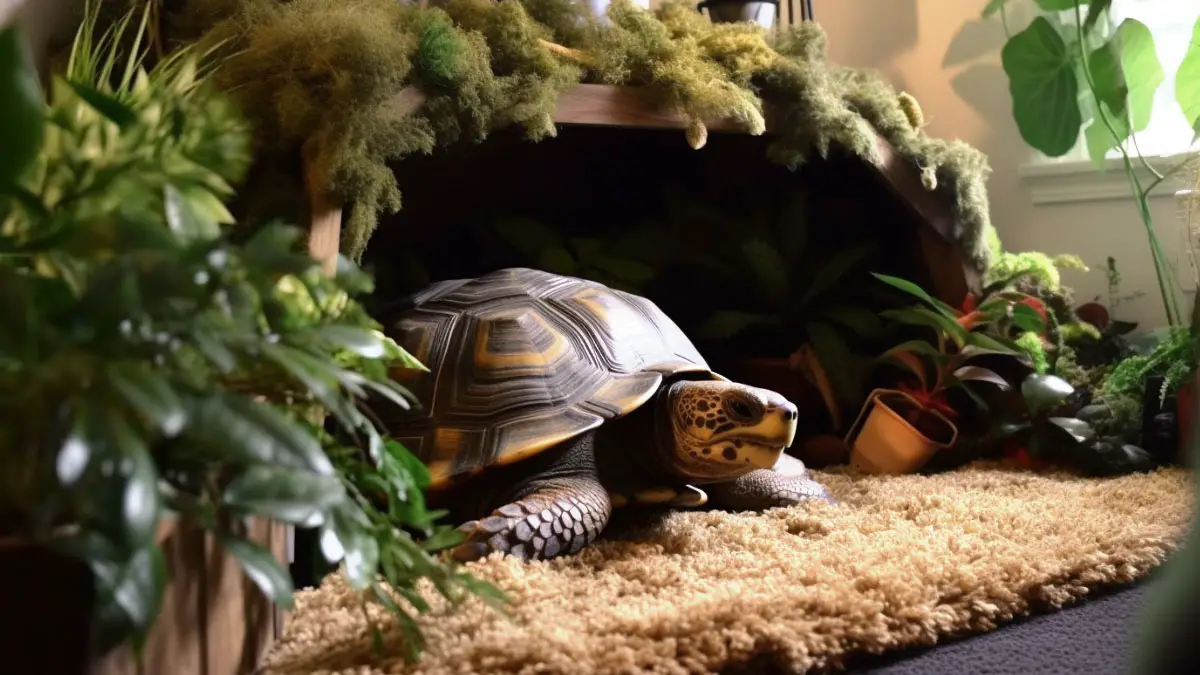How To Tell How Old A Tortoise Is? Age-Proofing Your Tortoise
Birth Date and record keeping are foolproof ways of determining a tortoise’s age. You can tag and keep records of your pet tortoise right from when they hatch, making age determination pretty straightforward.
But how to tell how old a tortoise is without any records or birthdate? You can still make an educated guess through:
- Counting growth rings on the tortoise’s scutes
- Measuring the tortoise’s size and weight
- Examining the condition of the tortoise’s shell
- Collection of blood samples from the tortoise
We’ll examine these four methods for determining a tortoise’s age in detail. This will shed light on the most reliable method to use.
How To Tell How Old A Tortoise Is?
Contents
There’s no clear-cut method, especially if you’re in the dark regarding the hatching date. That said, there are bound to be some discrepancies, making these methods more of a rough estimate.
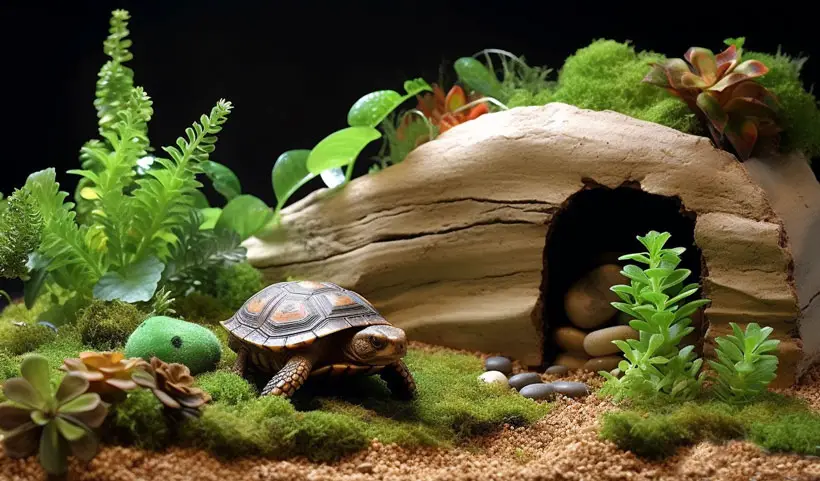
Nevertheless, blood sample tests tend to hit close to the mark. Even at that, the results are only as reliable when done by a certified vet.
1. Counting Growth Rings on the Tortoise’s Scutes
A tortoise’s shell has scutes, more like the scaly overlay on a crocodile’s skin. Just like the annual rings of a tree trunk, these scutes also develop rings with age.
- Essentially, each ring equals one year of growth. So, counting these growth rings can give you an age estimate.
Have a look at this video to learn how to count.
However, the growth ring method isn’t entirely accurate. And for a good reason, factors like environmental conditions and diet can cause a significant variation in the number of rings.
- A tortoise on a high-protein and calcium diet, for instance, may develop growth rings faster.
- Moreover, the rings may weather or wear down due to environmental conditions. For this reason, your tortoise may develop several rings or none.
- Also, according to the British Herpetological Journal, the growth ring method is only as good for young tortoises up to 5 years, offering an accuracy of up to 76%.
- But from age 6 years and beyond, only 16% of tortoises tend to develop one ring per year. To compensate for this, most experts recommend dividing the ring count by two for age estimation.
2. Measuring the Tortoise’s Size and Weight
As tortoises grow, their size increases over time. As such, younger tortoises tend to be smaller than older ones. For instance, a Sulcata tortoise should measure 24 to 30 inches and weigh 70-100 pounds as an adult.
- So, you can get an idea of your tortoise’s age by measuring its shell length and weight.
- Primarily, you want to measure the shell length. However, only measure it as a straight line, not a curve.
Watch the video on how to do that.
- But like the ring growth method, size and weight measurement aren’t entirely accurate. There are bound to be size variations due to diet, gender, and genetics.
- Also, tortoises in the wild tend to register slow growth, reaching maximum size in 15-20 years. Their captive counterparts will often reach full size in 4-5 years.
Some experts recommend using sexual maturity for age determination. Still, sexual maturity is more of a matter of size. In that regard, captive tortoises will reach sexual maturity at 4-5 years, while those in the wild will make it at 15-20 years.
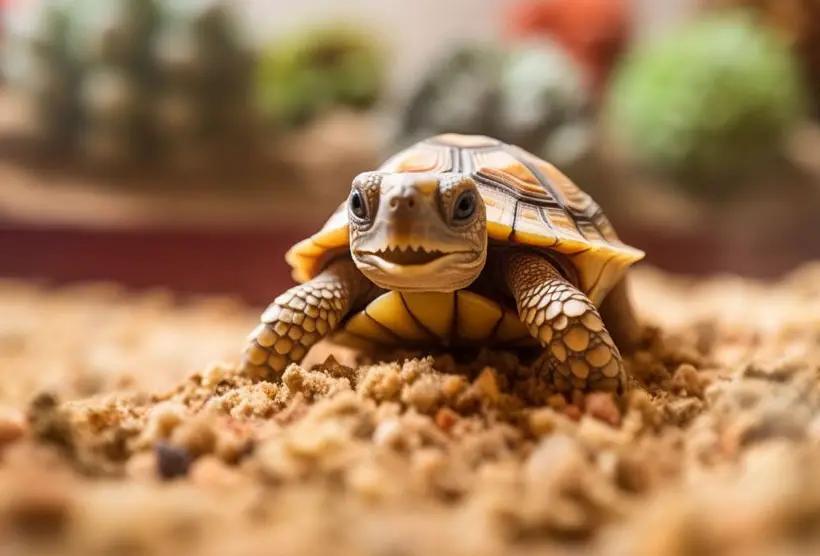
But our interest is in tortoises in captivity. So, here’s a tortoise size and age chart for popular pet tortoises in the table below.
| Species | Maximum Shell Length (Inches) | Max Weight (Pounds) | |
| Male | Female | ||
| Egyptian | 3-4 | 4-5 | 105-450 (grams) |
| Greek | 5.5-6 | 7-10 | 2-5 |
| Leopard | 10-18 | 12-18 | 28-30 |
| Russian | 5-7 | 7-10 | 1.5-4 |
| Hermann’s | 7 | 8-9 | 7-9 |
| Red-footed | 11-13.5 | 10-11.25 | 20-30 |
| Indian Star | 7 | 10 | 3-4.9 |
| Sulcata | 30-42 | 24-36 | 80-100 |
| Yellow-footed | 15-25 | 14 | 25-35 |
| Burmese | 24 | 24-30 | 70-100 |
| Spider | 4.5-6 | 5-7 | 200-400 (grams) |
| Aldabra | 48 | 36 | 350-550 |
| Elongated | 12 | 12-14 | 7 |
| Marginated | 12-14 | 10-12 | 9-11 |
| Radiated | 15-16 | 15-16 | 25-30 |
3. Examining the Condition of the Tortoise’s Shell
Besides shell length, you can tell the age of the tortoise by shell condition.
- Generally, it takes 5 years for a tortoise shell to harden. Therefore, a soft shell indicates a tortoise that’s 5 years or younger. It’s incredibly soft for tortoises up to 6 months.
- On the other hand, older tortoises will have worn and weathered shells. They’ll have a smooth texture often with discoloration.
- But again, this method is only an estimate. Shell conditions can be affected by diet and environmental conditions. For instance, too much protein and less calcium may cause pyramids. On the other hand, dirty living conditions may cause shell rot.
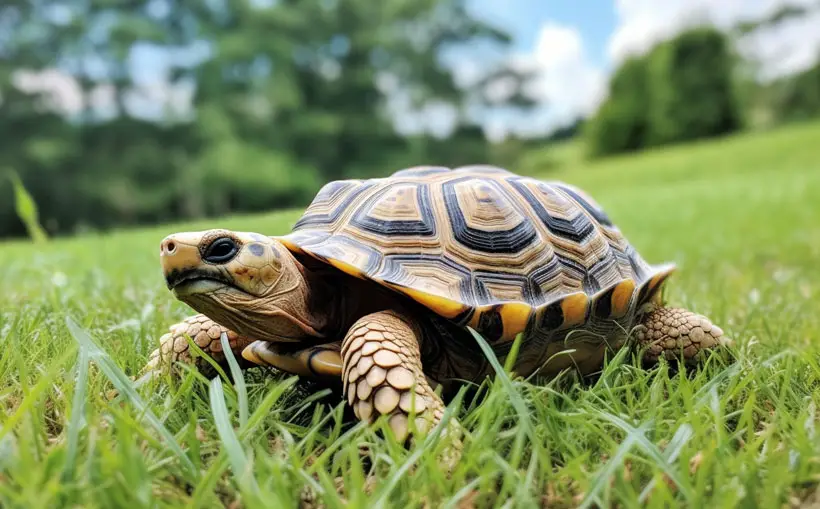
4. Collection of Blood Sample From The Tortoise
A blood test by a vet is the closest thing to telling the exact age of a tortoise. A vet will typically draw a blood sample from the subvertebral sinus, a vein underneath the tortoise’s neck.
The vet will then analyze it to get a metabolic profile that can help estimate the tortoise’s age. This method is more accurate than age determination based on shell size, shell texture, and growth rings. Even at that, this method isn’t foolproof, and the age estimate can only be considered an approximation.
Tortoise Age Limit
There’s no fit-it-all age limit for tortoises. Diet and genetics significantly affect the life expectancy of a tortoise.
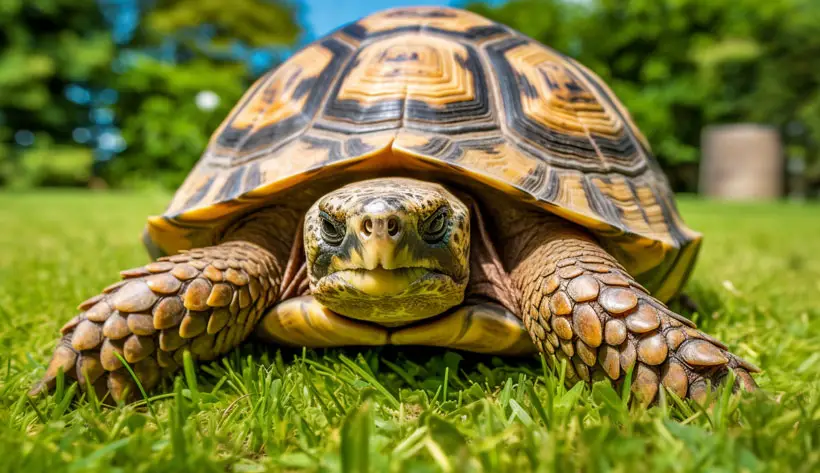
Nonetheless, a majority of tortoise species have a life expectancy of 80-150 years. Some species like the Galapagos and Aldabra giant tortoises, may live longer, up to 250 years. The table below shows the tortoise species and their average lifespan.
| Tortoise Species | Life Expectancy |
|---|---|
| Egyptian Tortoise | 50-100 years |
| Greek Tortoise | 50-90 years |
| Leopard Tortoise | 80-100 years |
| Russian Tortoise | 40-50 years |
| Hermann’s Tortoise | 50-90 years |
| Red-footed Tortoise | 30-50 years |
| Indian Star Tortoise | 35-80 years |
| Sulcata Tortoise | 80-100 years |
| Yellow-footed Tortoise | 50-60 years |
| Burmese Tortoise | 60-100 years |
| Spider Tortoise | 70 years |
| Aldabra Tortoise | 80-120 years |
| Elongated Tortoise | 40-50 years |
| Marginated Tortoise | 100-140 years |
| Radiated Tortoise | 40-50 years |
Accordingly, we have a few record holders for the longest-living tortoises. This tortoise age data is as per the official records. Get to know them from the table below.
| Tortoise Name | Species | Age | Status |
|---|---|---|---|
| Jonathan | Aldabra | 191 years | Living |
| Adwaita | Aldabra Tortoise | 255 years | Deceased |
| Harriet | Galapagos Tortoise | 175 years | Deceased |
| Tu’i Malila | Radiated Tortoise | 188 years | Deceased |
How To Tell A Tortoise’s Gender?
As said earlier, shell size measurements can provide a rough estimate of a tortoise’s age. Nevertheless, males and females showcase size differences. But how do you tell a male tortoise from a female?

Physical Characteristics of Male Tortoises
- A longer tail extending beyond the edge of the shell
- Concave plastron (bottom part of the shell)
- V-shaped notch in the shell
- Enlarged and upturned gular horn
- Enlarged chin glands
Physical Characteristics of Female Tortoises
- Flat plastron
- Short tail
- U-shaped notch in the shell
- Small gular horn
- The shape of the shell notch is typically a distinguishing factor in Russian tortoises, where the physical differences are not as pronounced. It may not be as reliable in distinguishing other tortoise species that don’t have distinct notches.
- In addition to physical characteristics, there may also be behavioral differences between males and females.
- Male tortoises would typically exhibit more aggressive behavior, especially during mating season. On the other hand, female tortoises may show nesting behavior.

Even at that, these behavior differences may not be reliable indicators of gender. After all, individual differences may also play a role. That said, a combination of physical characteristics and behavioral observations is a more accurate way of determining the gender of your tortoise.
FAQs
Let’s dig into some popular questions and answers related to how to tell how old a tortoise is.
As your tortoise grows, its dietary and environmental needs change, so it is essential to know its age to provide appropriate care. In addition to their care, knowing a tortoise’s age is also crucial for conservation efforts and research.
Primarily, it can help researchers understand the effects of environmental factors on the lifespan of a particular tortoise species.
A tortoise goes through four life stages: Egg, hatchling, juvenile, and adult. Most mating activity is in spring, with most tortoise species having an incubation period of 70-120 days.
Multiplying the tortoise’s age by a certain factor is the most common method for calculating a tortoise’s age in human years. The turtle age calculator suggests that one human year is equivalent to two tortoise years.
Conclusion
You can only pinpoint the exact age of a tortoise if you know when it was born. Even at that, you can still get an estimate by examining the tortoise’s shell texture, size, and growth ring count. Nevertheless, factors like diet, environment, and genetics can affect age calculation.
While these methods are not entirely accurate, you can combine them and also ask your vet to do a blood sample test. This may give you a figure that’s close to the real deal. Skeletochronology is also an option. Unfortunately, you can only do this type of testing on a deceased tortoise.

